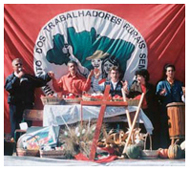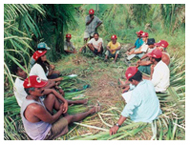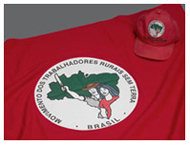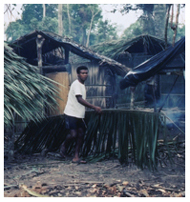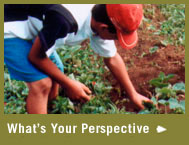"We cannot depend on the government, an institution, or a party. It has to be done by ourselves." —Geraldo Fontes, MST, 2004
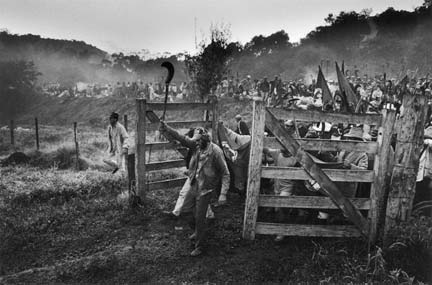
Members of the Landless Workers' Movement launch an occupation, 1996
Courtesy Sebastião Salgado-Amazonas/Contact Press Images
Courtesy Sebastião Salgado-Amazonas/Contact Press Images
As in other countries, small farmers in Brazil are being driven out of business by large multinational corporations. These companies own much of the country's richest farmland, including land often left idle.
Poor families have banded together to form the Movimento dos Trabalhadores Rurais Sem Terra (MST), or Landless Workers' Movement, to settle this land and begin subsistence farming. Waving the movement's flag, settlers begin by occupying the farmland and building a new community. MST was formally named in 1984 and celebrated 20 years of activism in 2004.
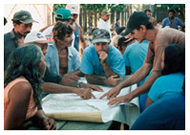 Members of an encampment meet in the school playground to plan the electricity grid, Pará, Brazil, 2005
Members of an encampment meet in the school playground to plan the electricity grid, Pará, Brazil, 2005Courtesy Dan Baron Cohen
Settlements begin with an acampamento (encampment) of tents built from tree branches and plastic. The Landless Workers' Movement then sets up schools on each encampment to promote primary education,
adult literacy, and activism. Families are also eligible for special credit programs, run by the government, which provide long-term loans for agricultural development.
Elected coordinators lead planning for community buildings including clinics, restaurants, and stores to sell goods produced by workers' farm collectives on the encampment. Over a thousand settlements have taken root since the Landless Workers' Movement began in 1984,
and the movement has more than 1.2 million members.
Settlers are often seeking escape from the violence, crime, and unsanitary conditions of the urban favelas (slums). Others, who may own or rent small plots of land, join as an alternative to sharecropping.
Special legislation adopted in 1988, known as the "Citizen Constitution," guarantees a series of rights to all Brazilians, including access to land. Yet landowners hostile to this redistribution have sometimes called in security forces
to evict settlers, some of whom have been injured and even killed.
Settlers grow manioc, beans, rice, corn, squash, grapes, coffee, yerba mate tea, and sugar. Members of the Landless Workers' Movement oppose genetically-modified crops, and many of the farms are organic. Because some migrate to rural settlements from the country's cities,
the group provides agricultural training to teach settlers how to look after the land and their crops.


